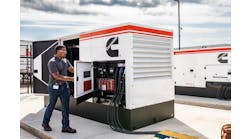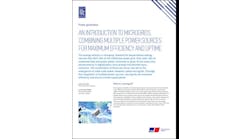Sharing Resiliency Lessons Learned From Japan on the Anniversary of Hurricane Sandy
Pace Energy & Climate Center’s Joseph O’Brien-Applegate and Tom Bourgeois explore the resiliency lessons learned following Hurricane Sandy, and insight that can be garnered from Japan’s experience with the superstorm.
By lavizzara/Shutterstock
As we mark the sixth anniversary of Superstorm Sandy, its impact is still fresh in the mind of many in the Northeast. These memories are reinforced by the still-unfolding damage done by Hurricane Michael, as well as that from hurricanes Harvey and Maria from 2017. Michael has left 1.3 million without power in the Southeast, and 17 dead so far. In 2012, Superstorm Sandy caused $19 billion in damages, left almost 2 million without power, and 43 dead in New York City alone.
In response to the damage caused by Superstorm Sandy and the prior year’s 2011 Halloween nor’easter, States across the Northeast launched programs to explore and promote the creation of microgrids. Microgrids are self-contained electric networks with on-site generation sources, and allow a number of buildings to operate even in the event of a power outage on the larger grid. Microgrids not only provide resiliency to critical infrastructure such as hospitals, government buildings, and first responders, they also provide places of refuge for displaced members of the community.
Microgrids with combined heat and power (CHP) are often the most cost effective means of providing affordable resiliency for campuses, blocks and neighborhoods. High efficiency, environmentally superior and economically advantageous CHP systems can serve a large portion of the normal electric and thermal loads for multiple buildings and customers who are in close proximity. The economic savings of providing both thermal energy and electric power from a single source, rather than separately purchasing power, heating and cooling can deliver a lower total cost of energy to the microgrid’s connected customers. CHP systems operating at total system efficiencies that are 50 percent or better than the status quo, typically deliver significant reductions in greenhouse gas and other harmful air pollutant emissions.
Tom Bourgeois, deputy director at the Pace Energy & Climate Center
In Tokyo, Japan, a similar need exists for resiliency and centers of refuge to assist with power outages of extended duration. Tokyo, like New York City, is concerned about increasing grid congestion and has aggressive goals to reduce emissions of carbon and other pollutants in a very high-density area.
We had the privilege to discuss two microgrids in Tokyo with Tokudai Neda of Tokyo Gas and professor Miki Muraki, of Chiba University Graduate School of Engineering. These projects address the multiple objectives of delivering low carbon energy and power at a high degree of reliability, to Tokyo’s neighborhoods.
The Tokyo Gas Group is promoting the development of “smart energy communities” to make smarter use of energy by connecting the buildings in a community via a heat and electric power network. At the same time, they are pursuing improvements at the building level to turn homes, office buildings, and factories into smarter energy users, according to a report from the company.
This is accomplished with a suite of resources including solar energy, combined heat and power, with communication, control and optimization systems that are designed to deliver Smart Energy Networks. One project, the Tamachi Smart Energy Network, connects six large buildings, including a hospital and a nursery school. The other project, Nihonbashi Area, consists of a new construction building with a central energy plant that will connect to existing buildings.
The Tamachi Smart Network
The Tamachi Smart Network is located near Tamachi Station in the center of Tokyo, and is separated into two “Blocks.” Block I consists of:
- A 10-story, 160 bed hospital
- An 8-story public building, which also serves as a center of refuge
- A 6-story nursery school
Joseph O’Brien-Applegate, energy analyst, Pace Energy & Climate Center
Block I is supplied by 845kW of CHP, 73 kW of PV solar, as well as incorporating solar water heating panels and ground water for hot and cold water. During the Fukushima Earthquake of 2011 over 200,000 households lost power. All three buildings in Block I will be able to operate islanded from the grid for over 72 hours.
Block II is under construction, and will contain:
- A 36-story office building
- A 31-story office building
- A 9-story hotel
Block II will have its own central energy plant with 5 MW of CHP, and also incorporate solar hot water heating.
The two central energy plants will each have smart controls and operation software, and will optimize their activity in tandem with each other based on the weather and the energy demand of each block. The two microgrids together will reduce CO2 emissions by 45 percent.
Nihonbashi Muromachi Smart Energy Network
The Nihonbashi Muromachi Smart Energy Network will connect a new-construction 25-story office building with existing buildings to create microgrid. The new construction building will house a central power generation plant with 23.4 MW of CHP, and will provide electricity, heating, and cooling to the entire microgrid. The individual buildings connected to the new plant will also have their own small CHP systems for use in the winter for heating, but will rely on the central plant for more economical power in the summer.
The energy plant will be operated by Mitsui Fudosan TG Smart Energy, who will sell electricity and steam to the microgrid. The microgrid will be capable of operating islanded for one week, and is expected to reduce emissions of the area by 17 percent.
The construction of the new building, central energy plant, and most importantly the steam tunnels and electric lines connecting the existing buildings will be coordinated with a revitalization of the Nihonbashi Area’s streets and sidewalks. This coordination will allow minimal cost and disruption from the construction of the microgrid.
International collaboration with our colleagues, as with the Tokyo Gas Smart Networks: Smart Energy Communities group can advance best practices and lessons learned in developing environmentally superior, economically beneficial, and resilient microgrids.
Lessons for New York and New Jersey
Commonalities between the development of microgrids in Japan and here in New York and New Jersey are that local factors, smart design and operation and a hospitable market and regulatory framework are indispensable to successful projects. Combined heat and power systems can be the centerpiece of affordable, resilient power districts that meet the highest environmental performance standards. One project under development in New York in particular, Proctors Theater in Schenectady, shares the business model and benefits of the projects demonstrated to us by Neda and professor Muraki. We were fortunate to receive a private tour of the planned facility organized by Congressman Tonko in August of this year.
Proctors Theatre is planning a microgrid across two blocks of downtown Schenectady. It will encompass the Theater itself, which houses an existing central heating and cooling plant that serves the area, as well as an adjacent hotel, and a commercial office and retail complex. The microgrid will be powered by approximately 1 MW of CHP, with additional thermal energy from the existing boilers and chillers.
Proctors is unique in that they already provide thermal and telecommunications services to surrounding buildings, but creating a microgrid to sell electricity to other customers still required a special Declaratory Ruling by the New York Public Service Commission exempting Proctors from regulation as a utility, and requiring National Grid to serve them. Codifying and clarifying the circumstances whereby microgrid developers can sell electricity to multiple/separate parties, as well as across right-of-ways, would greatly decrease the cost and time for developing microgrids.
Regulatory clarification regarding the terms and conditions of microgrid development and operation including fair and consistent practices in purchase and use of in-place capital equipment is absolutely essential to permit the market to develop, innovate and mature. Equally important is just recognition of the utilities’ interests as well as protocols for utility / microgrid interaction that fairly assigns costs and performance responsibilities. As the demand for smart, local, resilient and clean community energy and power continues to grow, regulatory bodies will have to set the legal structure and market framework that best advances the public interest. International collaboration with our colleagues, as with the Tokyo Gas Smart Networks: Smart Energy Communities group, can advance best practices and lessons learned in developing environmentally superior, economically beneficial, and resilient microgrids.
Joseph O’Brien-Applegate is an energy analyst, and Tom Bourgeois is deputy director at the Pace Energy & Climate Center;
This post originally ran on the Pace Energy & Climate Center blog.







